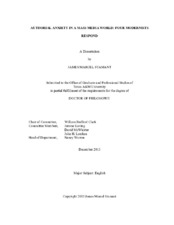| dc.description.abstract | This project explores the anxieties authors of the early twentieth century experienced in relation to mass media, particularly newspapers and the movies, focusing on the selected works of four modernist authors: Sherwood Anderson, James Joyce, F. Scott Fitzgerald, and Ernest Hemingway. The works I examine span a twenty-year period, from the late 1910s to 1940, when both the newspaper and movie industries were firmly established as “mass” media. I submit that these authors sustained very complicated relationships with the media they were in contact with. While all four of these authors worked for a time in one of these media, they maintained a negative attitude toward these same media when writing about them in their fiction. All four of these authors depicted perceived flaws in the very media they participated in.
Anderson and Joyce, critiquing the newspaper world, suggest that newspapers fail to fulfill expectations regarding “real” and accurate representations of the world. Anderson’s portrayal offers different reasons for the medium’s inabilities than Joyce’s, but both authors’ fiction comes to comparable conclusions of the newspaper business’ inadequacy to compete with the representations that could be found in literary fiction. Fitzgerald and Hemingway, writing about the movie business, highlight what they see as that medium’s shortcomings, and though both Fitzgerald and Hemingway personally held great optimism in the potential of movies they ultimately suggest otherwise in the fiction I examine.
For these authors, the anxieties they felt were quite real. Some of the worries that these four authors held existed long before their time and continue to persist in the media saturated world of the early twenty-first century. Whatever reservations these authors had, though, they did not preclude them from envisioning the possibilities of different media, participating in those media, and utilizing their experiences (both real and imagined) in their own literary fiction. The connections between media and authorship in the early twentieth century were extremely complex, and the blurred lines between different modes of communication—as well as the definitions of “art”—created concerns that these four authors expressed in the best way they knew how: in their literary works. | en |


